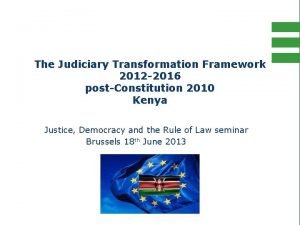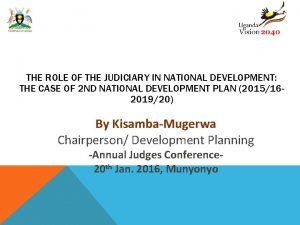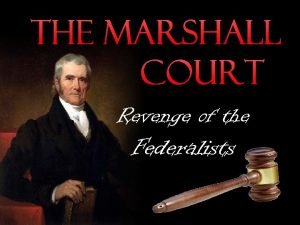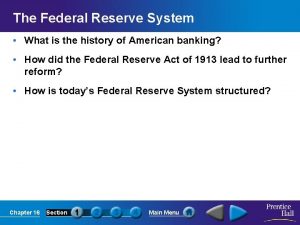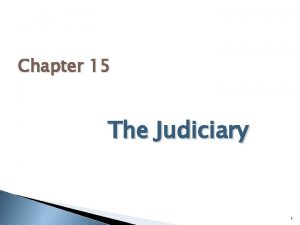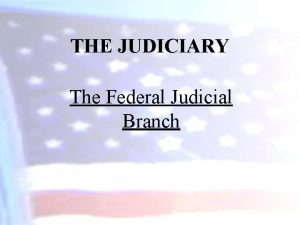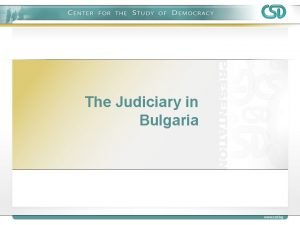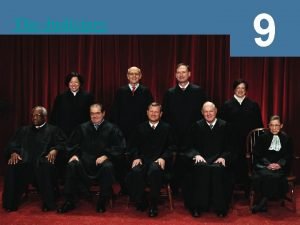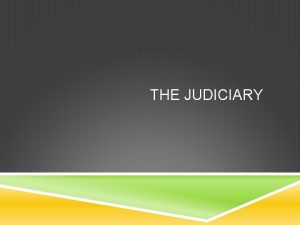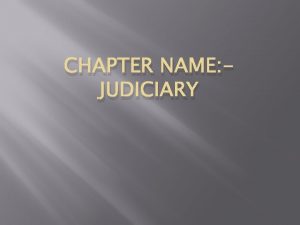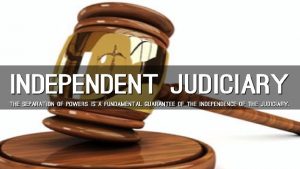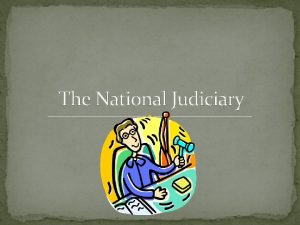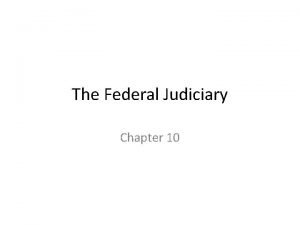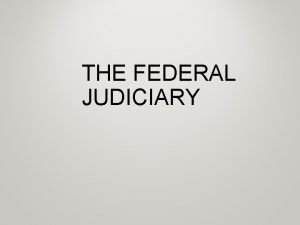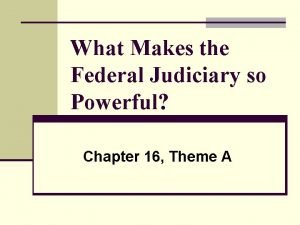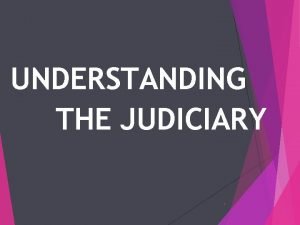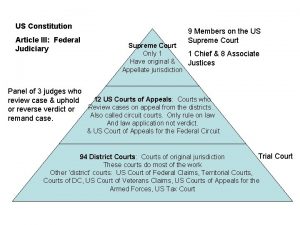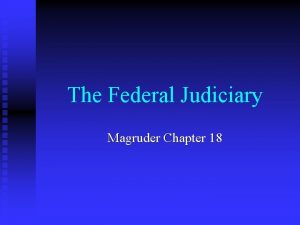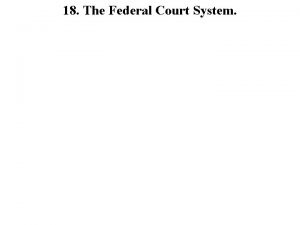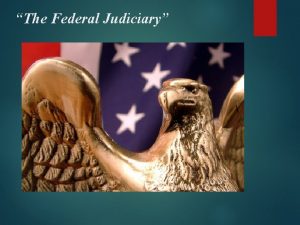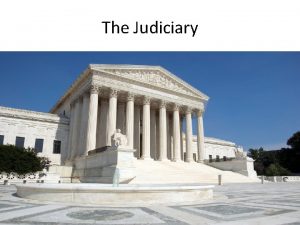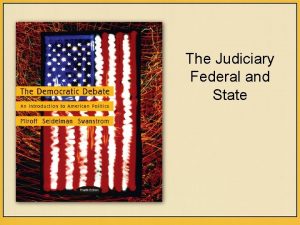The Judiciary The History of the Federal Judiciary























- Slides: 23

The Judiciary The History of the Federal Judiciary

History of the Supreme Ct u. The power of the Supreme Court evolved slowly u. The Supreme Court’s immediate priority was to establish its institutional legitimacy

History of the Supreme Ct u. This goal was accomplished in a series of developments under the leadership of Chief Justice John Marshall

History of the Supreme Court u(1) defeat of the impeachment proceeding, based purely on political charges against Justice Samuel Chase that validated the doctrine of judicial independence

History of the Supreme Ct u(2) the issuance of a single majority opinion that enabled the court to speak with one authoritative voice in lieu of each justice writing separately; and

History of the Supreme Court u(3) assumption of the power of judicial review in Marbury v. Madison (1803), making the Supreme Court an equal partner in the governing process with Congress & the president

History of the Supreme Ct u. Once secure in its position, the Supreme Ct turned to the task of adjudication

History of the Supreme Court u. The history of the Supreme Court decision-making falls into three (3) areas differentiated by the type of issue that dominated judicial attention during a particular time period

Three Eras of the Supreme Ct u From 1787 to 1865, federalstate relations and slavery were the great issues u In Marbury v. Hunter’s Lessee (1816), the Court asserted its right to impose binding interpretation of federal laws upon state courts

1787 -1865 v. Maryland (1819) upheld the supremacy of the federal government in conflict with a state over a matter not clearly assigned to federal authority by the Constitution u. Mc. Culloch

1787 -1865 u. Although federal preeminence was written into constitutional theory, it was not until after the Civil War that theory applied in practice

1787 -1865 u In fact the Court played an important role in intensifying regional tensions through its decision in Dred Scott v. Sandford (1857) in which federal law (the Missouri Compromise) prohibiting slavery in northern territories was ruled unconstitutional

1787 -1865 u. This decision, moreover, was only the second time that a federal law was declared unconstitutional by the Supreme Ct

1787 -1865 u. The Supreme Court’s reluctance to use judicial review attests to its still uncertain status in the early part of the 19 th century

1865 -1937 u. The dominant issue was the relationship between government and the economy

1865 -1937 u. The Court acted to support property rights and held that the due process clause of the 14 th Amendment protected commercial enterprises from some forms of regulation

1865 -1917 u The justices were merely reflecting the prevailing laissezfaire philosophy of that time u The Court, however, was not blind to the injustices of capitalism & upheld state regulations in over 80% of such cases between 1887 -1910

1865 -1917 u As the justices attempted to balance the public interest against private property rights, their decisions became riddled with inconsistencies: u (1) in distinguishing reasonable from unreasonable regulation or u (2) in separating interstate from intrastate regulation

1865 -1937 u. According to Justice Holmes, the Court had lost sight of its mission by forgetting that “a Constitution is not intended to embody a particular economic theory”

1865 -1937 u. The necessities of the Great Depression would compel a revision in constitutional theory on economic issues

1938 -present u Court has switched its focus to the protection of personal liberties u This change was partially prompted by the political pressure generated by FDR’s unsuccessful effort to pack the Supreme Ct with justices favorable to his New Deal programs

1938 -present u. As the Court allowed the government a freer hand on economic regulation, it took up challenges presented by social and political upheaval following WWII, such as free speech and racial integration

1938 -present u. A number of civil liberties cases in the Court’s docket began to shrink during the conservative appointments of Reagan & Bush u. Post 9/11. .
 Judicial transformation framework
Judicial transformation framework Judicial activism vs judicial restraint
Judicial activism vs judicial restraint Cohesive society and preserved identity
Cohesive society and preserved identity Department of judiciary
Department of judiciary Judicial hierarchy in india
Judicial hierarchy in india Vuk cucic
Vuk cucic Whats the judiciary act
Whats the judiciary act History of floral design
History of floral design Shin floral design definition
Shin floral design definition History of floral design chapter 2
History of floral design chapter 2 Federal reserve system history
Federal reserve system history Also history physical
Also history physical Hát kết hợp bộ gõ cơ thể
Hát kết hợp bộ gõ cơ thể Lp html
Lp html Bổ thể
Bổ thể Tỉ lệ cơ thể trẻ em
Tỉ lệ cơ thể trẻ em Gấu đi như thế nào
Gấu đi như thế nào Thang điểm glasgow
Thang điểm glasgow Alleluia hat len nguoi oi
Alleluia hat len nguoi oi Các môn thể thao bắt đầu bằng tiếng đua
Các môn thể thao bắt đầu bằng tiếng đua Thế nào là hệ số cao nhất
Thế nào là hệ số cao nhất Các châu lục và đại dương trên thế giới
Các châu lục và đại dương trên thế giới Cong thức tính động năng
Cong thức tính động năng Trời xanh đây là của chúng ta thể thơ
Trời xanh đây là của chúng ta thể thơ
